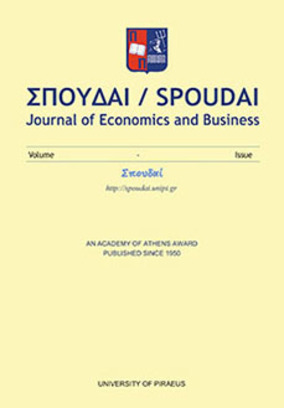Exploring fire incidents/accidents onboard cruise and passenger ships
Part of : Σπουδαί : journal of economics and business ; Vol.63, No.3-4, 2013, pages 146-157
Issue:
Pages:
146-157
Author:
Abstract:
The aim of this paper is to present aspects of the implemented statistical analysis and patterns of the recorded maritime fire accidents. In this context, a focused database was created taking into account the specific sources for the data available; hence, the data was collected from selected cruise/passenger operators which provided information regarding the events of ignition, and generally smaller or bigger fires which took place onboard vessels. A key achievement of this effort is the healing of the usual problem of underreporting of fire accidents; in particular, underreporting small fires in relative (commercial) databases is a common problem in drawing reliable and usable risk related conclusions. However, the results presented in this paper are based upon a rather complete set of fire records providing this way for reality reflecting results and error free conclusions. Based on this database, the paper presents the results derived by statistical analysis which are able to provide patterns and trends of fires onboard passenger and cruise vessels. Furthermore, information about actually recorded occurrences/frequencies in relation to fire ignition and fire development is also included. This approach allows exploring, in a quantitative manner, the issue of fires for the examined fleet by giving specific figures regarding the frequency of events per ship-year, and the expected number of events per year. Finally, a series of tests is performed to identify whether the recorded patterns and relationships are statistically significant observations or whether they are solely attributable to chance. The paper concludes with insights drawn from the aforementioned topics.
Subject (LC):
Keywords:
maritime fire accidents, cruise/passenger vessels, ignition, statistical analysis, risk, hypothesis tests
Notes:
Περιέχει πίνακες, διαγράμματα και βιβλιογραφία, Special Issue: Management of maritime safety, security and environmental protection
References (1):
- Darbra, R.M. and Casal, J., 2004. Historical analysis of accidents in seaports. Safety Science. 42(2).85-98.Da Veiga, J.L., Loggia, B.D. and Segarra, R.M., 1999. Final Report of the PHOENIX Project,Barcelona, Spain.Gentile, M.J. and Dickenson, R.P., 1995. Casualty Data Analysis of the World Merchant Fleet forReported Fire and Explosion Incidents Resulting in Marine Pollution (DOT-VNTSC-CG-94-7). Cambridge, MA: U.S. Department of Transportation Report.Guarin, L., Logan, J., Majumder, J., Puisa, R., Jasionowski, A. and Vassalos, D., 2007. Design for fire safety.[Online] Available: http://www.safety-at-sea.co.uk/pdf/2007_Design_for_Fire_Safety_paper_1.pdf(20 May 2011).Hakkarainen, T., Hietaniemi, J., Hostikka, S., Karhula, T., Kling, T., Mangs, J., Mikkola, E. andOksanen, T., 2009. Survivability for ships in case of fire (Research Notes 2497). Espoo, Finland:Final report of SURSHIP-FIRE project, VTT Tiedotteita.IMO, 2001. Guidelines on alternative design and arrangements for fire safety. MSC/Circ. 1002.London, UK: International Maritime Organization.IMO, 2002. Guidelines for Formal Safety Assessment (FSA) for use in the IMO rule-making process.MSC/Circ.1023/MEPC/Circ.392, London, UK: International Maritime Organization.Ingster, Yui., 2000. Adaptive chi square tests. Journal of Mathematical Sciences. 99(2). 1110-1119.Joannovich, J., Panayotou, P., Tsoutsos, D., Filopoulos, E., Yannopoulos, A., Alexakis, D. andStriglis, C., 1992. Marine fire casualties in merchant ships: the Greek statistics, in M. Masellisand S.W.A. Gunn (Eds.). Management of Mass Burn Casualties and Fire Disasters (pp.106-109). Hingham, MA: Kluwer Academic Publisher.Mendiola, S., Achutegui, J.J. and De la Rosa M.A., 1999. Fire Ranks Second in Maritime Casualties.[Online] Available: www.seaman.or.kr/.../ mn_ down. php?.. .FIREPROTECTIONONBOARDEnhanceFiresafetybyDesign, (15 February 2010).Nikolaou, N. and Spyrou, K., 2010. Assessment of fire vulnerability of passenger ships. Proceedingsof the Marine Technology Conference. Limassol, Cyprus.Oikonomou, K. and Ventikos, N.P., 2010. Study of F/X Accidents in the Global Fleet: Analysis, Resultsand Elements of Risk, Proceedings of the Annual Conference of Maritime Technology,Piraeus, Greece.Siskinda, V., Steinhardta, D., Sheehana, M., O’Connor, T. and Hanks, H., 2010. Risk factors forfatal crashes in rural Australia. Accident Analysis and Prevention. 43(3). 1082-1088.Soares, C.G. and Teixeira, A.P., 2001. Risk assessment in maritime transportation. Reliability Engineeringand System Safety. 74(3). 299-309.Spyrou, K., 2010. Ship Design for Safety and Environmental Protection. Athens, Greece: NTUAPress.Ventikos, N.P., Lambrinakis, K., Nitsopoulos, S.C. and Lyridis, D.V., 2007. Fires/Explosions OnboardGreek Vessels: The Hazards, the Records & the Statistical Trends. Journal of HarbinEngineering University, 27[Suppl.]. 1-8.Ventikos, N.P. and Psaraftis, H.N., 2005. A Review on the Integration of Human Factor in MarineSafety: The Sleeping Giant under the Spotlight. Proceedings of EAM 2005 International Conference.Athens, Greece.Vlaun, R.C., Kirkbride, G.B., Pfister, J.G. and Rosenblatt, M., 2001. Large Passenger Vessel SafetyStudy – Report on the Analysis of Safety Influences. Arlington, VA: The International Councilof Cruise Lines Report.




